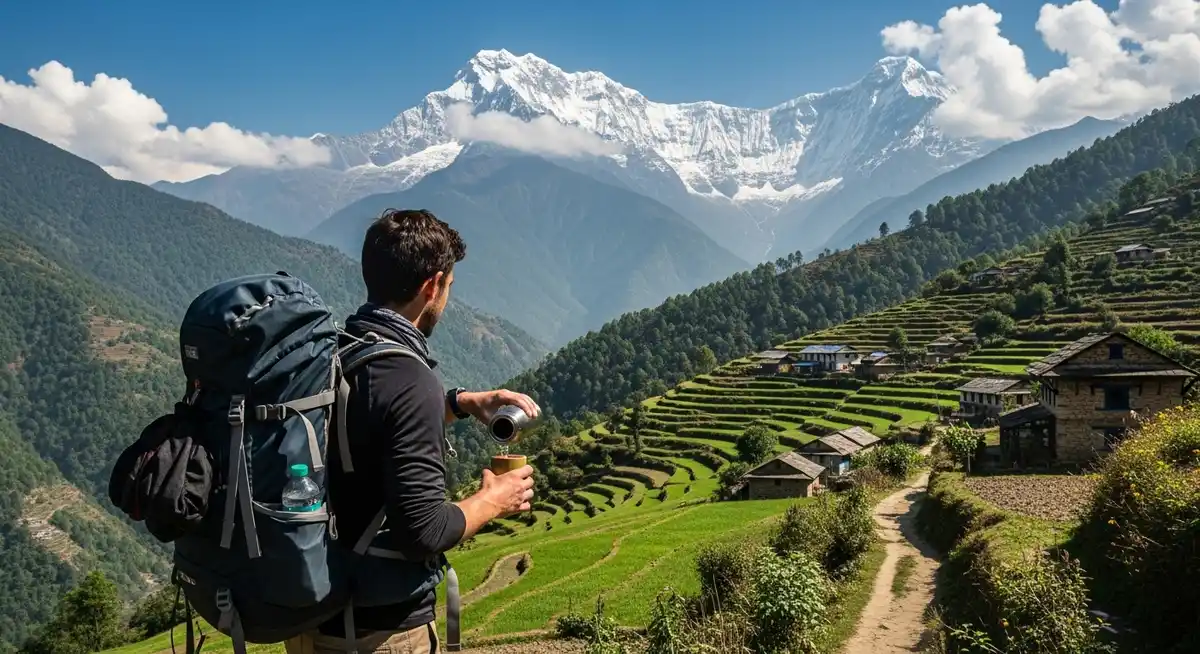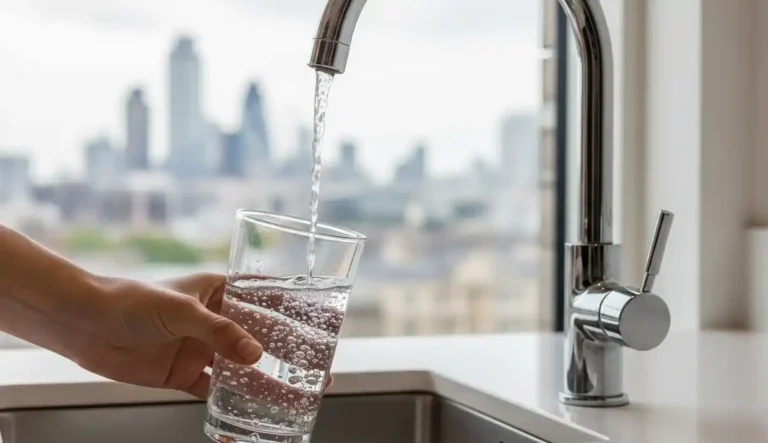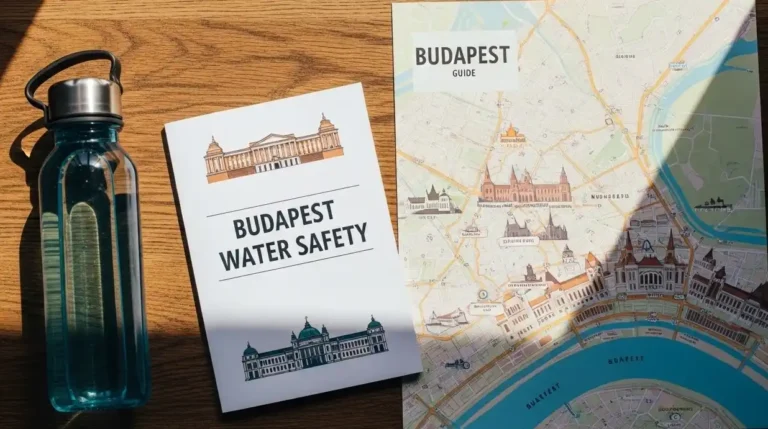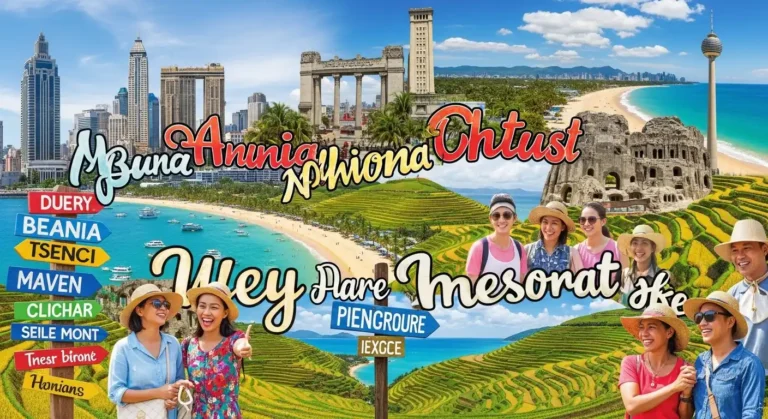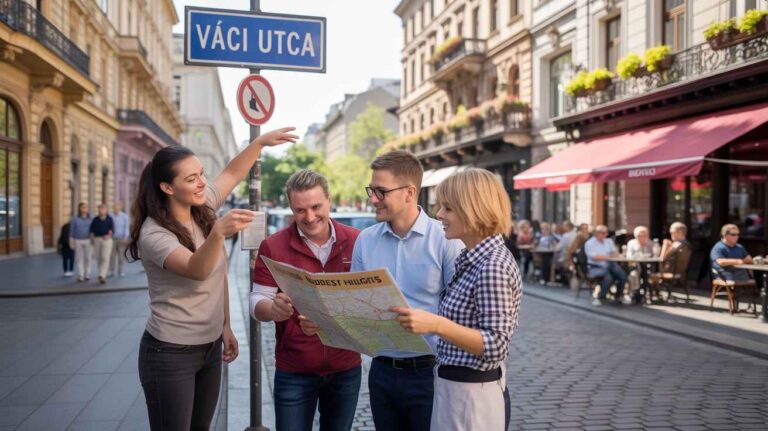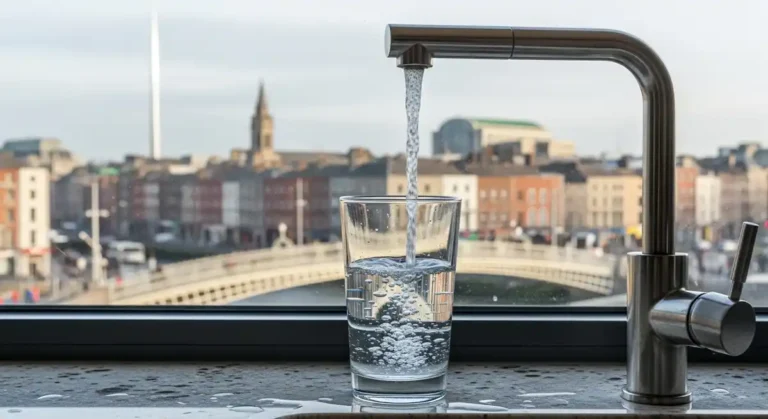Nepal Drinking Water Safety 2025: What Travelers Must Know
Planning a trip to Nepal in 2025? Water safety is on everyone’s mind. From Kathmandu to the high Himalayas, knowing the smartest ways to drink safe water can turn your journey into a smooth, worry-free adventure.
Yes, you can find safe tap water in Nepal in 2025, but most people prefer bottled water, water jars, or a purification system for everyday drinking and cooking. Both locals and travelers choose these options for safe human consumption when visiting Nepal, including trekking regions and remote areas.
In Nepal, people rely on clean options like bottled water and large gallon water jars for daily drinking. Many households, hotels, and restaurants also use a purification system to make sure the water is safe. From my own time visiting, I noticed how locals, foreign tourists, and even Nepali families keep water ready for cooking and human consumption.
During trekking in the regions and remote areas, carrying or arranging safe water is common. It is easy to order water, and it helps both travelers and tourists stay healthy while exploring. People are always careful, and this makes the experience smoother and stress-free.
- Tap water safety: Not safe for drinking due to untreated groundwater, poor infrastructure, and climate change impacts.
- Safe drinking options: Bottled water, gallon jars, boiled water, purification tablets, and portable filters/purifiers are reliable.
- City & trekking use: In Kathmandu and trekking areas, people use bottled or boiled water, hotel water jars, or personal purification methods.
- Household use: Tap water can be used for brushing teeth, washing dishes, and showering if not swallowed; safer to use treated or bottled water for cooking and rinsing produce.
- Trekking safety: Boiling, purification tablets, portable filters (LifeStraw, Sawyer), UV sterilizers (SteriPEN), or solar disinfection (SODIS) keep water safe on trails.
- Health risks: Diarrhea and stomach issues are common if drinking untreated water; prevention means sealed or treated water. If sick, use ORS, take loperamide, and see a doctor if symptoms persist.
- Cost of safe water: Bottled water costs 25–35 Rs. in cities, up to 350 Rs. on treks; gallon jar refills cost 80 Rs.; boiled water costs 100–200 Rs. per litre.
- Global comparison: Unlike countries with naturally pure tap water (Iceland, Switzerland, Norway), Nepal requires purification but is steadily improving.
- Everyday hygiene: Ice and ice cream are safe when from reputable places; cooked food and hot drinks are always reliable choices.
Why Isn’t Tap Water Safe in Nepal? (Context & Causes)
Tap water in Nepal is often not considered safe because of untreated groundwater, damaged infrastructure, climate change impacts, and limited piped system coverage. These factors affect the quality of water, leaving communities with a heavy reliance on shallow hand pumps and other sources that need proper treatment.
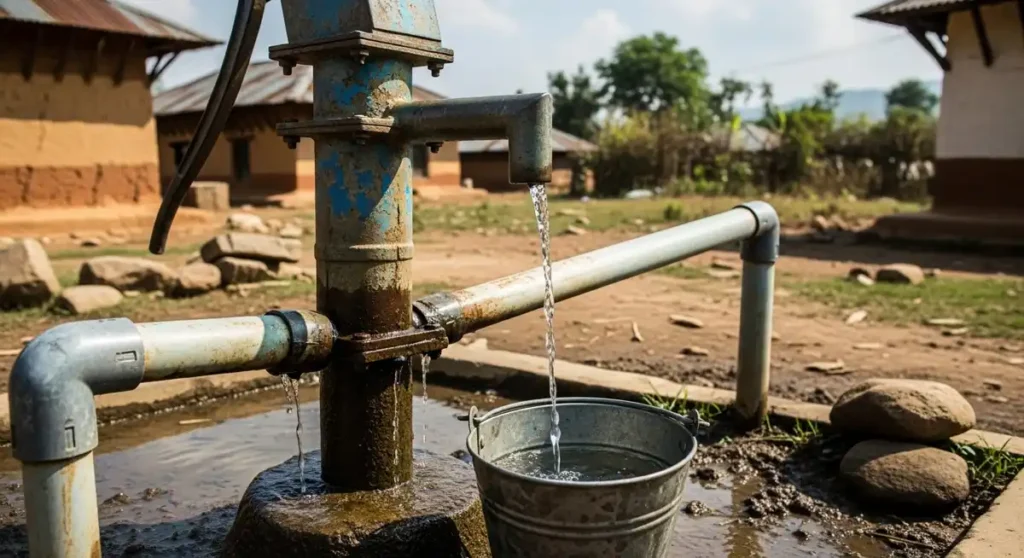
In Nepal, the quality of tap water depends on many things. People use untreated groundwater, and sometimes shallow hand pumps give water that looks clean by appearance or temperature. But safe consumption requires proper treatment to protect communities from bacteria and possible waterborne diseases.
Extreme weather events like floods and landslides can bring changes to water supply systems and infrastructure in rural areas. Climate change also shapes precipitation patterns, affecting springs and how water flows. With the right planning, sustainable water systems can manage these challenges well.
Good results come with investment. When there is no insufficient funding, water infrastructure can grow stronger. With maintenance and fair water tariffs, it is possible to sustain existing piped systems and expand safely managed water to more places.
Rising temperatures and shifting rainfall patterns highlight the need for groundwater recharge and support for drying springs. By caring for water sources, people can reduce contamination and make the most of available supply.
Improvements in coverage of piped water systems show progress. Even if some systems are limited or not fully functional, steady steps forward mean more of the population can rely on treated and safe water for daily use.
The context shows that high reliance on untreated sources is changing. Better awareness of health impacts and stronger focus on safety help reduce risk. By reaching marginalized communities and addressing economic vulnerability or social vulnerability, people can overcome challenges from climate shocks and continue steady development.
Can Locals Drink Tap Water in Nepal?
In Nepal, tap water is usually not used for direct drinking, but locals and travelers can make it safe for consumption by boiling, using purification tablets, or a water filter. Many people also choose bottled water or filtered water, which are always recommended options.
For everyday life in Nepal, locals who were born and raised there often make tap water ready for consumption through simple steps. Boiling for a minute, adding purification tablets, or using a water filter helps keep the supply clean and purified. These methods are not only easy but also help to avoid any issues and make water enjoyable to drink.
In many areas, people also keep bottled or filtered water at home, which is always recommended. Hotels and guesthouses often provide safe options too, so both visitors and locals can rely on treated and purified choices. Whether it is boiled water, filtered water, or bottled water, there are plenty of simple ways to enjoy safe drinking water in Nepal.
Can You Drink Tap Water in Nepal in Kathmandu?
In Kathmandu, Nepal, people usually drink clean water from water jars, bottled water, or by refilling their own water bottle in hotels and teahouses. Visitors can also buy safe bottled water in many shops, which is often the best option during daily travel or while exploring trekking regions and remote areas.
In Nepal’s Kathmandu, many travelers prefer to keep a water bottle with them and refill it when possible. Most hotels provide large water jars, and sometimes there is a small fee for refilling. For convenience, shops everywhere sell bottled water, making it simple to buy whenever needed. Carrying your own bottle also helps reduce waste and supports a better recycling system.
When moving across trekking regions or passing through remote areas, keeping safe drinking habits is important. Local teahouses and guesthouses often guide visitors on the best option for water.
Many travelers bring a water bottle and make sure it is filled and ready before they consume water in these places. This way, whether in the busy streets of Kathmandu or on the trails of Nepal, drinking water remains easy and comfortable.
Safe Drinking Water Options in Nepal (2025 Guide)
Traveling in Nepal 2025 gives many travelers the chance to explore mountains and high altitudes, but finding the safest drinking water is very important. I often relied on trusted sources and reputable bottled water brands with intact seals. These felt like safe alternatives when moving between cities and villages.
The most reliable way for me was boiled water. It is a proven method and only requires longer boiling times at higher altitudes. Sometimes, when I hiked, I carried water purification tablets. The tablets containing chlorine or iodine can effectively kill bacteria and viruses, making water safe to drink.
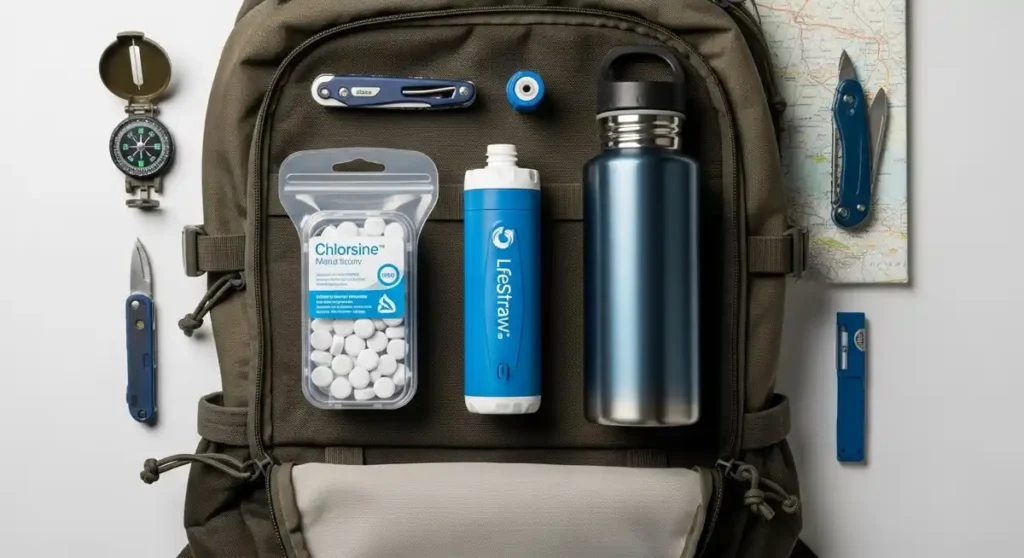
Here are the best options that worked for me and many other travelers:
- Boiled water – works well even at high altitude with extra boiling time.
- Bottled water – pick reputable brands and check intact seals.
- Water purification tablets – light to carry, strong against germs.
- Filters and purifiers like LifeStraw – easy to use and can remove contaminants.
- Filtration systems from trusted sources – useful for longer stays.
I also used a reusable, high-quality plastic or stainless steel bottle such as a BPA-free Nalgene. This helped me reduce plastic waste while still keeping water safe. In hotels and guesthouses across cities like Kathmandu, many followed water safety plans and offered filtered water. I always liked to confirm the source and learn about their treatment methods before filling my bottle.
Trekking & Adventure Travel: Water Safety on the Trails
Water Safety on the Trails means using smart ways like boiling water, water purification tablets, portable water filters, UV purification devices, and solar water disinfection (SODIS) to make streams, lakes, and other water sources safe for trekkers and hikers. These methods keep hydration, support energy levels, prevent altitude sickness, and ensure a healthy trekking experience in Nepal and other remote areas.
When trekkers and hikers go into remote areas, they rely on smart water purification. Natural streams and lakes may carry microorganisms, so clean and safe water is key to maintaining good hydration, steady energy levels, and enjoying high-altitude treks without worries of fatigue or altitude sickness. I’ve seen how choosing a reliable purification method, along with good hygiene, makes every trip smoother.
One simple choice is boiling water. Placing it in a container over a heat source until it reaches a rolling boil removes bacteria, viruses, and protozoan parasites. Treated this way, the water is pure and refreshing for consumption during trekking or camping.
For easy and portable options, many travelers use water purification tablets, chlorine, or iodine. These chemicals are affordable and effective against germs and pathogens in almost any water source. On trekking trails in Nepal, I often noticed whitish water treated with chlorine, and after a while its appearance returned to normal.
Modern tools like portable water filters also make life easier. I carry one in my backpack, and it clears dirt and other contaminants quickly. Some popular filters are the Sawyer Squeeze, LifeStraw Personal Water Filter, and the AQUASIV Day Hiker Squeeze Filter. They are lightweight, simple to use, and great for a healthy trekking experience.
Another method is UV purification devices. With ultraviolet light, they block the genetic material of microorganisms. Devices like SteriPEN Ultra and LARQ bottles are favorites among hikers. They work fast and need only a small power source like batteries or solar panels for the UV lamp.
When traveling in undeveloped areas, I like solar water disinfection (SODIS). It uses transparent plastic bottles in sunlight, and the ultraviolet rays make the water potable. This cost-effective and environmentally friendly method fits well with environmental sustainability goals and helps reduce single-use plastic bottles.
On long trekking days, I stay hydrated with treated water from teahouses, tea shops, or by carrying my own. I also use sealed bottles with a valid expiration date, enjoy carbonated beverages, tea, or coffee, and carry ORS packets with salts and electrolytes to balance sweat loss. I watch my urine color — light yellow means I’m fine.
Using reusable bottles and different purification methods ensures drinking water is always safe, supports environmental sustainability, and keeps every journey filled with energy and joy.
Everyday Questions Travelers Ask
Can you drink tap water in Kathmandu hotels?
In Kathmandu hotels, guests usually enjoy bottled or treated water. Options like sealed bottles, boiling, purification tablets, or a filter make the water fresh, clean, and ready to drink.
When traveling in Nepal, it is common for hotels to provide guests with securely sealed bottled water. Many places also use methods like boiling or purification tablets, or they offer water that has been run through a filter. These simple practices ensure the supply is reliable, giving travelers peace of mind and keeping them healthy throughout their stay.
During my own stay in Kathmandu, I found the available options both convenient and refreshing. The water provided was always properly treated, making it easy to stay hydrated and enjoy the trip without any concern. By relying on treated water, visitors can focus fully on the beauty and experiences the city has to offer.
Can you brush your teeth with tap water in Nepal?
Yes, you can brush your teeth with tap water in Nepal as long as you don’t swallow it. Many people also use drinking water, bottled, boiled, or treated water if they prefer extra care.
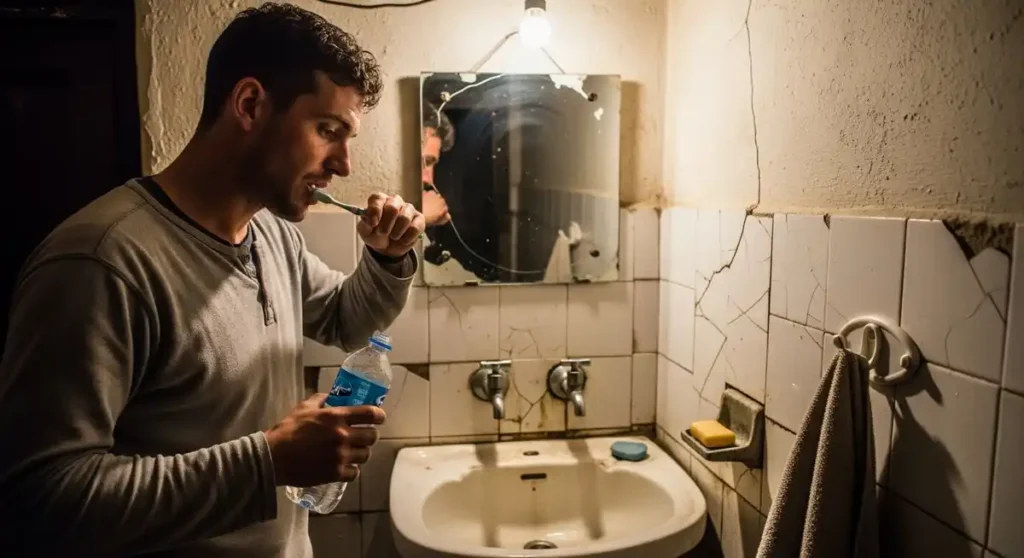
Brushing your teeth in Nepal is simple. The tap water is fine for daily use when you remember not to swallow it. On my first trip to Asia, I tried both drinking water and tap water, and with time I became comfortable.
Some travelers like to use bottled, boiled, or treated water. Others gradually adjust to the local tap water when they spend longer there. It is also recommended to keep your mouth closed in the shower. This way you stay safe and fresh while enjoying your stay.
Is it safe to use tap water for cooking in Nepal?
In Nepal, people often use boiled, bottled, or purified water for cooking, as it keeps food fresh, tasty, and safe for locals, travelers, and tourists.
In everyday life across Nepal, families and restaurants rely on sealed bottled water or freshly boiled water when preparing meals. Many also enjoy using purified or filtered water through a reliable purifier, making every dish clean and enjoyable.
When handling salads or rinsing raw vegetables, I prefer using filtered water so the freshness remains. Both locals and travelers follow this simple habit, which makes tourists feel comfortable too. Proper treatment of tap water simply adds more care to daily cooking and ensures that every shared meal brings health and delight.
Can I wash fruits/vegetables with tap water?
Yes, you can wash fruits and vegetables with tap water, and many people also like to use purified, boiled, or bottled water for an extra layer of care. A good practice is to soak the produce in clean water with a little vinegar, which helps keep it fresh and ready to eat.
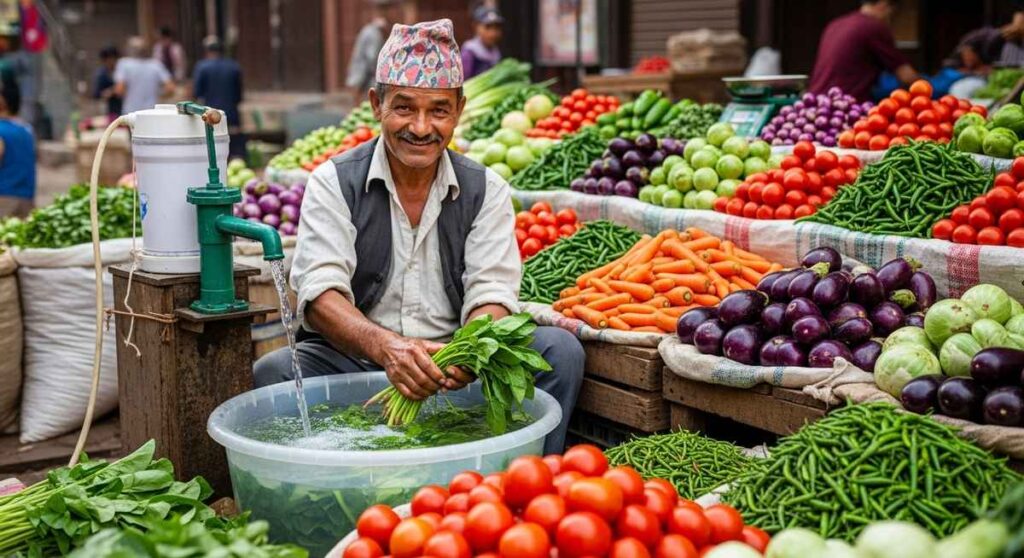
Fruits and vegetables stay at their best when rinsed well in tap water before you eat or cook them. Many families also prefer using purified, boiled, or bottled water, which is seen as a safer and better habit, especially for raw foods.
Another simple practice is to soak your produce in water and add a bit of vinegar. This step naturally kills off surface germs and keeps the vegetables and fruits fresh. I often do this myself while traveling, and it only takes a little time.
Whether you plan to cook your vegetables or enjoy them raw, this method makes them taste good, keeps your stomach feeling light, and adds confidence to every meal.
Is it safe to shower with tap water in Nepal?
Yes, it is safe to shower with tap water in Nepal. The water is generally clean enough for showering, but it is better not to swallow it. For brushing teeth and hygiene, many travelers prefer bottled, boiled, or purified water.
In Nepal, you can enjoy a shower with tap water as long as you keep your mouth closed. The water is fine for showering, and I have used it many times during my travel. While it is not meant for drinking, it feels refreshing and helps maintain daily hygiene without any worry.
For extra care, I often used bottled or boiled water with purified tablets for brushing my teeth and rinsing. Some hotels also provide filtered water from boreholes or use their own purifiers and filters, which give travelers more control over quality. If staying for an extended period, having a small purifier can be useful.
These precautions are simple and easy, and they make the experience of showering in Nepal safe, fresh, and worry-free.
Can I drink water in teahouses while trekking?
Yes, you can drink water in teahouses while trekking in Nepal. The water is usually boiled, or you can use your own purification methods like tablets, a LifeStraw, or a SteriPEN. You may also buy bottled water or enjoy hot beverages such as tea, coffee, or soup.
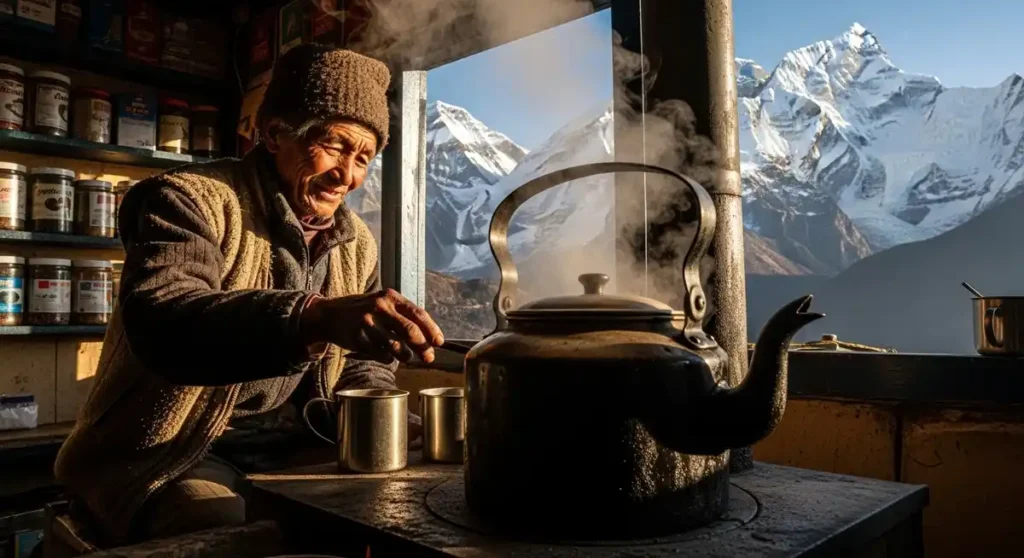
While trekking in Nepal, most teahouses offer water that is made safe to drink. Many trekkers ask to have it boiled and then fill their bottle again. Using a purification tablet of iodine or chlorine is also common, as these quickly purify the water from bacteria and viruses. Some travelers prefer tools like a LifeStraw, SteriPEN, or filters, which act as a personal purifier and make the effect fast and reliable.
If you want, you can also buy bottled water from teahouses, but many choose to get their bottles refilled to reduce plastic and support better waste management. Trekkers enjoy a mix of options, from commercially sealed bottles to freshly treated water.
Along the trail, many also sip hot beverages like tea, coffee, or soup, which are always refreshing and naturally safe. Whether using methods like UV sterilizers, tablets, or simply ordering a hot drink, you will always find a good way to stay hydrated and responsibly cared for while trekking.
Can I drink water from rivers/streams in Nepal?
Fresh water in Nepal’s rivers and streams can be safe to drink if properly treated. Using a reliable filter, LifeStraw Water Bottle, boiling, or chemical tablets ensures the water is clean. High-altitude streams and springs often appear pure, but treating the water is the safest way to enjoy it without risk.
Fresh water in Nepal comes from mountains, mountainous places, streams, and springs. Many people use this water for drinking, especially when exploring rivers or hiking in remote areas. Streams at higher elevations often look pure, and with proper precautions, you can enjoy them safely.
To stay safe, always use a water filter, such as a LifeStraw Water Bottle, or boil the water. Chemical tablets can also purify water, making it safe for drinking. Proper treatment removes bacteria, viruses, and parasites, ensuring waterborne illnesses do not occur. With these precautions, water from streams and springs is generally safe to drink, even in remote mountainous places.
Is ice safe in Nepal? What about ice cream?
Ice-cream in Nepal is safe to enjoy when bought from proper ice-cream sellers and reputable hotels or restaurants. Ice made from purified or treated water is safe to consume, and bottled water or hot, well-cooked food is a reliable choice for travelers.
Ice-cream in Nepal can be a delightful treat. Many small shops in the countryside sell locally made ice-cream from buffalo milk, which can be enjoyed when purchased from trusted sellers. Foreigners often find it easy to eat without issues if they choose well-known shops or reputable hotels.
Ice made from purified or treated water is safe to consume. Many hotels and restaurants follow strict hygiene practices to ensure safe drinks and food. Travelers can enjoy ice-cream and ice confidently when choosing reliable sources.
Bottled water or hot, well-cooked food is always a safe and refreshing option. Local sources of water are carefully monitored, and following trusted standards helps maintain a healthy experience while exploring Nepal.
Can you use tap water to wash dishes?
Tap water in Nepal can be used to wash dishes safely if it is treated, boiled, filtered, or purified. Using a cloth or tissue to dry dishes afterward ensures they are ready for use with food. Some larger towns have government treatment plants that provide safer water.
Tap water in Nepal is generally usable for washing dishes, especially when extra care is taken. Using boiled, filtered, or purified water can make it even safer. Wiping dishes dry with a cloth or tissue before use helps ensure they are clean and ready for food.
In larger towns, government treatment plants provide safer water, making the process easier. For cooked or completely dry dishes, the risk is lower, and a careful approach ensures everything is hygienic. Using these simple steps keeps bacteria and pathogens away while maintaining a healthy kitchen.
Health Risks & What to Do If You Get Sick
Drinking tap water in Nepal can contain natural microorganisms. To stay healthy, choose sealed, bottled, boiled, or filtered water. Enjoy bland foods, stay hydrated, and consult a doctor if needed. Using purification tablets and practicing safe eating habits ensures your water experience is safe and comfortable.

Common Health Risks
Drinking water in Nepal may contain small amounts of natural bacteria, viruses, or parasites. Some people notice diarrhea, nausea, cramps, or mild fever, but these can be easily managed. Enjoy water from safe sources and keep your body hydrated. Minor digestive adjustments are common when exploring new places, and simple care helps your system adjust smoothly.
If You Get Sick
If your body reacts, stay hydrated with clean water. Eat bland, easy-to-digest foods to support your digestion. Medical help is available if symptoms persist, and a doctor can offer guidance. Services like home visits or local clinics are convenient. Listening to your body and taking gentle care ensures a comfortable experience.
Prevention is Key
Always choose safe water sources, such as sealed, bottled, boiled, filtered, or disinfected water. Handle food carefully by boiling, cooking, or peeling fruits and vegetables. Avoid raw foods or items made with unknown water sources. Be mindful of ice and select busy eateries with clean kitchens. Following these simple practices keeps your water experience safe and enjoyable.
Enjoying tap water in Nepal is safe when you use precautions. Choose boiled, sealed, or filtered water and use purification tablets if needed. Eat bland foods, stay hydrated, and seek medical attention if necessary.
Understanding potential bacterial, viral, or parasitic contamination helps you prevent issues and enjoy your stay comfortably. Focusing on prevention ensures your water experience supports your health and well-being.
Comparing Nepal’s Water Safety with Other Countries
Nepal’s tap water is treated and safe when proper purification methods like boiling or purification tablets are used. Compared to countries like Iceland, Norway, and Switzerland, which have high-quality water sources and advanced infrastructure, Nepal is steadily improving water safety standards. Travelers and locals can enjoy clean water by using safe alternatives like bottled water or proper purification methods.
Nepal provides tap water that is safe to use with simple purification steps. Travelers and locals often boil water, use purification tablets, or opt for bottled water to maintain purity. Direct consumption is safe when these proper purification methods are followed, making daily use convenient.
Other countries like Iceland, Norway, and Switzerland enjoy naturally pure water sourced from pristine resources such as glacial melt. Their high-quality water sources are contaminant-free and managed through advanced infrastructure. Nations like Finland and Canada are also recognized for excellent water quality.
Nepal is continuously enhancing water safety standards. Environmental factors and infrastructural factors are considered to maintain safe tap water. By using safe alternatives and following proper purification methods, everyone can enjoy clean and refreshing water. The key takeaway is that both locals and travelers can access safe water through simple precautions.
Cost of Safe Drinking Water in Nepal
In Nepal, travelers and locals have many good options for safe water. A 1.5 litre bottled bottle is the most average choice, with a price that stays between 25-35 Rs. or sometimes 35.20 N₨. On treks, the range can rise to 350 N₨ because of the higher altitudes, but it stays easy to find.
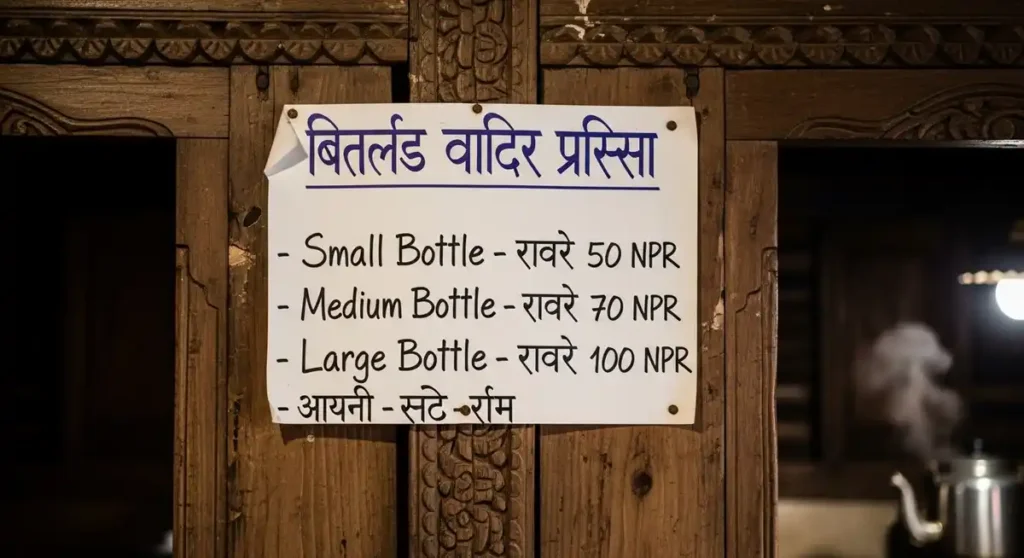
For long-term stays, many people choose gallon jars of 19 liters. The first time, there is a deposit of 300 Rs., and after that, you only pay 80 Rs. to swap an empty jar for a new one. This is often the best option as it is safe, simple, and necessary for daily use.
Another choice is boiled or hot water, often purchased in small pots. In the evening, a pot of tato pani (umaleko pani) can cost 150-450 Rs.. Typically, a litre of boiled water is 100-200 Rs., which is especially useful during treks. Many people also use it for tea or warming sleeping bags. These costs may increase a little around higher places, but safe water is always available and easy to get.
Treatment for Diarrhea
Treatment for diarrhoea from drinking tap water in Nepal includes using ORS (Oral Rehydration Solution) to replace lost fluids and electrolytes, taking Imodium or loperamide to manage symptoms, and visiting a doctor for antibiotics if it lasts for more than two days. Always use bottled or treated water for drinking and brushing teeth to prevent future illness.
Medicines are easily available in many pharmacies across Nepal, and the staff often speak English to guide you. Before you trek into villages or small areas, it is wise to pack medicines like Imodium or imodium for a possible stomach bug. These are helpful for travelers and can make your journey better.
If you face diarrhoea or diarrhea from consuming contaminated tap water, start by drinking Oral Rehydration Solution (ORS) to rehydrate and keep your body strong with enough fluids and electrolytes.
You may also use antimotility agents such as loperamide to manage symptoms. If symptoms last for more than a few days, it is best to seek medical advice from a doctor who may recommend an antibiotic or antibiotics.
To avoid future illness, always use bottled or treated water for drinking and brushing teeth. While on a trek, I carried ORS and medicines, and even in remote Lower Mustang, the teahouse owner had the right remedies.
Following these immediate steps and keeping an eye on dehydration is key, especially if you have high blood pressure, since staying hydrated keeps travel safe and enjoyable.
Conclusion
In Nepal, many households, hotels, and restaurants rely on 5 gallon or 19 litres water jars for drinking and cooking. Some also use a purification system, while others simply order clean water jars to make daily consumption easy and safe.
With so many options, from bottled to boiled or purified water, you can explore freely and enjoy every step of your journey. The conclusion is simple: having the right water choices keeps you refreshed and lets you experience the best of Nepal without worry.
Frequently Asked Questions
Is Nepal tap water safe to drink?
Tap water in Nepal is not usually used for direct drinking. Most people choose bottled water, large jars, or boiled and filtered water. These options keep drinking safe and easy for both locals and travelers.
Can I brush my teeth with tap water in Nepal?
Yes, you can brush your teeth with tap water in Nepal as long as you do not swallow it. Many people also prefer using bottled, boiled, or filtered water for extra care.
Is coffee safe to drink in Nepal?
Yes, coffee in Nepal is safe to drink. It is usually made with boiled or purified water, which makes it fresh and safe for daily enjoyment.
Which water is best for drinking in Nepal?
The best water for drinking in Nepal is bottled, boiled, or filtered water. Many people also use purification tablets or portable filters when trekking.
Can you drink the tap water in Kathmandu?
In Kathmandu, most people drink bottled water, water jars, or boiled water. Hotels and shops provide safe water, and travelers often carry their own bottles for easy refills.
Disclaimer
This article is for informational purposes only. Water conditions and safety practices can vary. Always check locally before use. Traveldrizzle.com does not provide medical advice; consult a professional if needed.
